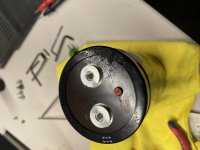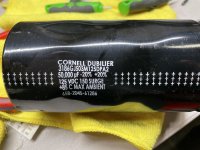Yesterday I posted the issue with my Mark Levinson 333 not powering up. I dismantled the unit and found one of the large capacitor "cans" (50,000uF/125V) to be leaking. Please see attached photos. This type (Cornell Dubilier) seems no longer available. Can somebody recommend me suitable capacitors for this unit? Considering the cost of these capacitors: Can I just replace one or do I need to replace all (2 per channel, total 4)?
Thanks!!
Thanks!!
Attachments
Hello, You will be not disapointed :
Exxelia - FELSIC 85 (Capacitors > Aluminum Electrolytic > Screw Terminals)
Exxelia - FELSIC 85 (Capacitors > Aluminum Electrolytic > Screw Terminals)
Always replace them as a group ($$$)
Especially with 25 year old capacitors burried in a metal shell,
likely subjected to great heat, not to mention the (AC ripple)
"charge current pulses" from those massive toroids.
ALL "older" big Levinsons will benefit PS work.
*I sold my No. 336 in 2010, after re-capping it.
It would be good to consider the driver stage caps too.
I wonder if this would fit?? If so?? Grab em while you can...
https://www.mouser.com/ProductDetail/Cornell-Dubilier-CDE/DCMC503M125DF2B?qs=5aG0NVq1C4xn30C0tmr0kA%3D%3D
Parts supply has been so rough, I order ~ 6 months
ahead of most .planned. projects. Best of luck.
Especially with 25 year old capacitors burried in a metal shell,
likely subjected to great heat, not to mention the (AC ripple)
"charge current pulses" from those massive toroids.
ALL "older" big Levinsons will benefit PS work.
*I sold my No. 336 in 2010, after re-capping it.
It would be good to consider the driver stage caps too.
I wonder if this would fit?? If so?? Grab em while you can...
https://www.mouser.com/ProductDetail/Cornell-Dubilier-CDE/DCMC503M125DF2B?qs=5aG0NVq1C4xn30C0tmr0kA%3D%3D
Parts supply has been so rough, I order ~ 6 months
ahead of most .planned. projects. Best of luck.
Last edited:
Yesterday I posted the issue with my Mark Levinson 333 not powering up. I dismantled the unit and found one of the large capacitor "cans" (50,000uF/125V) to be leaking. Please see attached photos. This type (Cornell Dubilier) seems no longer available. Can somebody recommend me suitable capacitors for this unit? Considering the cost of these capacitors: Can I just replace one or do I need to replace all (2 per channel, total 4)?
Thanks!!
Good that you found the cause of your problem.
In a simple way you can measure how well the remaining caps are.
When you measure the current, then according to I=C*du/dt you can calculate how much voltage drop is allowed in 1/(mains freq*2) and check it on a scope.
It would be a waste of money to replace them all when still O.K.
Succes,
Hans
@ozark: Thanks - These caps were replaced by an authorized ML service station only 6 months ago. So I am less than pleased... I found the capacitors you suggested as well. Unfortunately 18 weeks delivery time. So I am desperately looking for someone to help me out.
@Hans: Will do, as soon as I replaced the faulty one (my amplifier is not powering up right now, I hope due to the faulty capacitor and some electrolyte spill on the driver board)
@Hans: Will do, as soon as I replaced the faulty one (my amplifier is not powering up right now, I hope due to the faulty capacitor and some electrolyte spill on the driver board)
When replaced 6 month ago I wonder whether you aren’t entitled for a free replacement.
The other question is, what happened to the original ones, do they still have them?
My experience is that these large original caps from ML never break down, not even after 30 years.
Hans
The other question is, what happened to the original ones, do they still have them?
My experience is that these large original caps from ML never break down, not even after 30 years.
Hans
@Hans, they offer a 3 month warranty on their work. Nevertheless I will ask them. On the other hand I am pretty sure that they disposed of the original caps. BTW: On my 23.5 years ago I had a caps failure of the original caps. But the replacement was easier back then....
Thanks for your feedback. Now I need to find replacement caps...
Thanks for your feedback. Now I need to find replacement caps...
May I ask out of interest whether one of the broken caps in your 23.5 was one of the big blue caps ?
I can hardly imagine, but all other caps in the 23.5 are failing regularly after so many years.
Hans
I can hardly imagine, but all other caps in the 23.5 are failing regularly after so many years.
Hans
Thx, I’m surprised.
And now for the second time in another model, so much bad luck
Could it be that there is something with your mains, living near heavy industry ?
Maybe a power conditioner could help to prevent future cap faulures.
Hans
And now for the second time in another model, so much bad luck
Could it be that there is something with your mains, living near heavy industry ?
Maybe a power conditioner could help to prevent future cap faulures.
Hans
Actually I have a conditioner, but I was living at a different place when the 23.5 failed. Yes, indeed bad luck. I just contacted the service station and they asked me to send photos of the capacitor. They will see how they can help.
A choke input filter would have been perfect for that amp. Instead it had to have a large toroid transformer, large caps and horrible power factor.
Clearly the amp has problems.
I am sorry ~ respectfully ~ you are mistaken Hans [not sure where you come to that perspective]
I owned a No 336 for ~10 years, bought it as a rep sample, from a lifelong friend. I have long term personal experience related to the topic, the actual product line and an inside perspective that I will not elaborate on further. My amp had all filter caps replaced at around 10 years... I sold it primarily, (not bashing on Levinson products) in that, I could no longer pick it up due to [unrelated] serious shoulder injuries.
Components (capacitors) that may measure well "on the bench", may not perform well at all in real world, with equipment like this. I am sorry. I do appreciate a more .grounded. optimism when trying to guide others. This amp clearly HAS PROBLEMS, perhaps this is a cap that was not replaced... who knows???
My experience is that these large original caps from ML never break down, not even after 30 years.
Hans
I am sorry ~ respectfully ~ you are mistaken Hans [not sure where you come to that perspective]
I owned a No 336 for ~10 years, bought it as a rep sample, from a lifelong friend. I have long term personal experience related to the topic, the actual product line and an inside perspective that I will not elaborate on further. My amp had all filter caps replaced at around 10 years... I sold it primarily, (not bashing on Levinson products) in that, I could no longer pick it up due to [unrelated] serious shoulder injuries.
Components (capacitors) that may measure well "on the bench", may not perform well at all in real world, with equipment like this. I am sorry. I do appreciate a more .grounded. optimism when trying to guide others. This amp clearly HAS PROBLEMS, perhaps this is a cap that was not replaced... who knows???
Last edited:
~ exactly ~
I agree a choke input would "protect" the PS components/caps.
But there is no room. The 3 series amps are PACKED! I credit Agosto for opening his and looking around. Even with (knowing at the time) 30 years of amplifier building and service work, my buddy highly discouraged me from doing this comprehensive work. You ave to tear it down, it is a serious effort.
A choke input filter would have been perfect for that amp. Instead it had to have a large toroid transformer, large caps and horrible power factor.
I agree a choke input would "protect" the PS components/caps.
But there is no room. The 3 series amps are PACKED! I credit Agosto for opening his and looking around. Even with (knowing at the time) 30 years of amplifier building and service work, my buddy highly discouraged me from doing this comprehensive work. You ave to tear it down, it is a serious effort.
My experience is with the older ML amps starting with no: 2x.x and never saw a problem with the big caps, maybe they were simply more ruggedized.I am sorry ~ respectfully ~ you are mistaken Hans [not sure where you come to that perspective]
Components (capacitors) that may measure well "on the bench", may not perform well at all in real world, with equipment like this. I am sorry. I do appreciate a more .grounded. optimism when trying to guide others. This amp clearly HAS PROBLEMS, perhaps this is a cap that was not replaced... who knows???
But for those PS caps when they don’t get warm as a sign of internal leakage and fullfil the U=I*du/dt test, I don’t see what can possibly be wrong with a PS cap.
Hans
Does anybody have schematics of the power supply and the driver/power amp section?
This is what I have,
Hans
Attachments
I agree a choke input would "protect" the PS components/caps.
But there is no room. The 3 series amps are PACKED! I credit Agosto for opening his and looking around. Even with (knowing at the time) 30 years of amplifier building and service work, my buddy highly discouraged me from doing this comprehensive work. You ave to tear it down, it is a serious effort.
Correct. It is not the most service-friendly design. To access the caps you need to disassemble the entire housing. I am also not sure how to bench test the driver/power amp sections as each side uses two multi-pin connectors to connect to the main board. I assume one has to fabricate connecting cables to make that work. Hopefully I do not need to do this and the only problem is the capacitor can.
- Home
- Amplifiers
- Solid State
- Recommendation for Capacitor "Cans" for Mark Levinson 333

